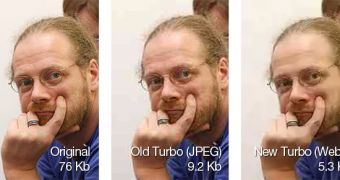The very latest Opera 11.10 has just been released. The perennial underdog in the browser wars has plenty of aces up its sleeve. One of the highlights of this latest release is an updated Opera Turbo, a technology that speeds up the web on slow connections by compressing elements of web pages.
The most interesting enhancement in the new Opera Turbo is the switch from JPEG to WebP-compressed images. In order to cut down on web page sizes, Opera Turbo re-compresses images at a lower quality setting.
This has noticeable effects on the images, but it's a trade-off for faster loads. However, using the open WebP, rather than the aging but hugely popular JPEG image standard, not only results in smaller sizes but also in better quality.
"In a jeep? On the train? On a horse? Yes, we enjoy outdoor activities too. But we also enjoy a fast Internet connection in places where you normally wouldn't expect it. That's why we made Opera Turbo," Opera's Audun Mathias Øygard wrote.
"The most noticeable difference is probably WebP. An open standard image format that was released with some fanfare by Google last year. We thought it was about time to replace the 20 year old JPEG format with something more modern," he explained.
"Overall, WebP produces images with less artifacts and crisper details, even though the image takes less space," he added.
WebP was introduced by Google last year as an alternative to existing lossy image compression standards, aka JPEG. While the JPEG format has served us well, it's getting rather old.
Yet, there's no actual competitor for it, there are some lossless formats and more advanced ones used by professionals but nothing for the mass market.
WebP is based on the VP8 video compression standard and produces significantly smaller images than JPEG compression of a similar quality. Opera Turbo uses WebP since it not only makes files smaller, it also produces images with less noticeable artifacts.

 14 DAY TRIAL //
14 DAY TRIAL //